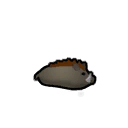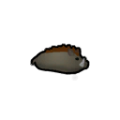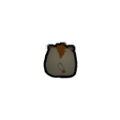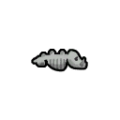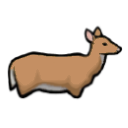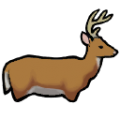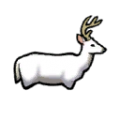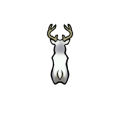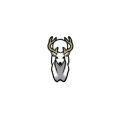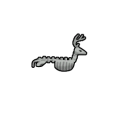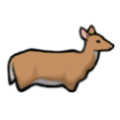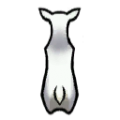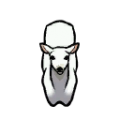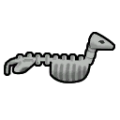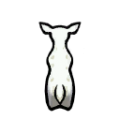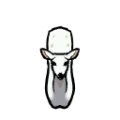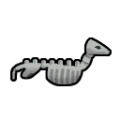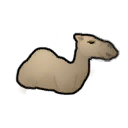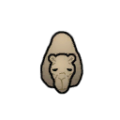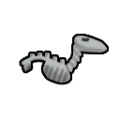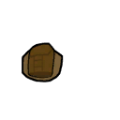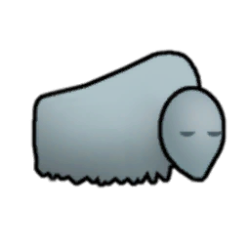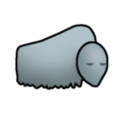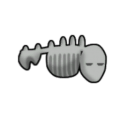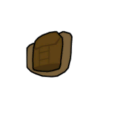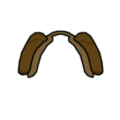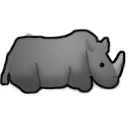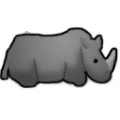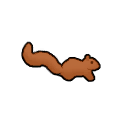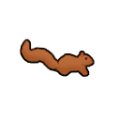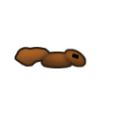Difference between revisions of "Herbivore"
(Added herbivorous animals not already listed.) |
(Added text.) |
||
| Line 1: | Line 1: | ||
| + | Herbivores are creatures that usually eat only [[plants]]. They usually rely on wild plants for sustenance but will eat any non-meat [[food]] items left lying about like vegetables, prepared [[meals]], [[chocolate]], and [[beer]]. | ||
| + | |||
<div style="clear:both;"> | <div style="clear:both;"> | ||
<div class="pull-left">{{:Boar}}</div> | <div class="pull-left">{{:Boar}}</div> | ||
Revision as of 02:28, 5 June 2015
Herbivores are creatures that usually eat only plants. They usually rely on wild plants for sustenance but will eat any non-meat food items left lying about like vegetables, prepared meals, chocolate, and beer.
Wild boar
This hairy omnivore is descended from escaped pigs and evolved for living in the wild.
Its tusks make it a better fighter than its domesticated pig cousins. Unfortunately, it is too unruly to be trained in the most complex tasks.
Base Stats
- Type
- Animal
- Flammability
- 70%
Pawn Stats
- Combat Power
- 55
- Move Speed
- 4.6 c/s
- Health Scale
- 70% HP
- Body Size
- 0.85
- Mass - Baby
- 10.2 kg
- Mass - Juvenile
- 25.5 kg
- Mass - Adult
- 51 kg
- Carrying Capacity
- 64 kg
- Filth Rate
- 16
- Hunger Rate
- 0.48 Nutrition/Day
- Diet
- omnivorous grazer
- Life Expectancy
- 12 years
- Manhunter Chance
- 0%
- Manhunter Chance (Taming)
- 0%
- Trainable Intelligence
- None
- Wildness
- 50%
- Minimum Handling Skill
- 4
- Roam Interval
- 2 days
- Mate Interval
- 12 hours
- Maturity Age
- 0.333 years (20 days)
- Juvenile Age
- 0.1 years (6 days)
- Comfortable Temp Range
- -23 °C – 40 °C (-9.4 °F – 104 °F)
Production
- Meat Yield
- 119
 pork
pork - Leather Yield
- 36
 pigskin
pigskin - Gestation Period
- 5.661 days
- Offspring Per Birth
- 1-2 (1.25 avg)
Melee Combat
- Attack 1
- Tusk
9.7 dmg (Scratch)
15 % AP
2 second cooldown - Attack 2
- Tusk
9.7 dmg (Stab)
15 % AP
2 second cooldown - Attack 3
- Teeth
8.5 dmg (Bite)
13 % AP
2 second cooldown
0.6 chance factor - Attack 4
- Head
5 dmg (Blunt)
7 % AP
2 second cooldown
0.2 chance factor - Average DPS
- 2.55
- tradeTags
- AnimalCommon
Boars are omnivorous wild pigs. They are quite pervasive, being found in . If slain, they can be butchered for pork and pigskin.
Summary
Wild boars are pen animals. Once tamed, pen animals cannot and do not need to be trained any further. But if left outside of a pen or caravan hitching spot, pen animals will eventually roam outside your colony. Making a caravan is not required to tie animals to a caravan hitching spot.
Wild boars can appear in raids alongside yttakin pirates. ![]() Note that "raider" boars are still unable to travel through fences and barricades. This can alter their pathing. If the animal raider cannot reach a better target because of fences/walls, it will start bashing at structures randomly.
Note that "raider" boars are still unable to travel through fences and barricades. This can alter their pathing. If the animal raider cannot reach a better target because of fences/walls, it will start bashing at structures randomly.
Analysis
Boars are one of many animals that exist primarily to be hunted.
As tamed animals, boars are worse for meat/leather than pigs. While boars can be found in the wild, they are generally outclassed for meat by at least 1 animal, regardless of what biome you've settled on.
Nutrition
When slaughtered, a boar yields Expression error: Unexpected < operator. meat and Expression error: Unexpected < operator. leather as a baby; Expression error: Unexpected < operator. meat and Expression error: Unexpected < operator. as a juvenile; or Expression error: Unexpected < operator. meat and Expression error: Unexpected < operator. leather as an adult. 1 meat is equal to 0.05 nutrition.
An adult boar consumes nutrition per day, and creates up to Expression error: Unexpected / operator. offspring per day.
- When offspring are slaughtered as babies, a female boar will produce Expression error: Unexpected < operator. nutrition of meat per day, giving a nutrition efficiency of Expression error: Unexpected < operator.%.
- If the offspring are allowed to grow to adulthood, they will consume an additional Expression error: Unexpected < operator. nutrition per day, but will instead yield Expression error: Unexpected < operator. nutrition per day as they are slaughtered, resulting in a nutrition efficiency of Expression error: Unexpected < operator.%.
When considering a population of equal numbers of males and females, these nutrition efficiencies fall to Expression error: Unexpected < operator.% for baby slaughter and Expression error: Unexpected < operator.% for adult slaughter.
Boars are inferior to pigs, chinchillas, ibex, and horses for meat / nutrition consumption. Pigs and horses take less slaughtering work, too. One of the few advantages of boars is that they are omnivorous, able to eat leftover human corpses, but pigs are also omnivores. If pigs are unavailable, then boars are the best for this task.
Combat
Boars are surprisingly powerful for their size, though boars will rarely fight. They won't revenge when hunted. As pen animals, they will never be attacked by raiders. But when they do attack, such as in manhunter packs, boars are threatening.
They have a damage output higher than that of a megaspider, with a movement speed equivalent to that of an unarmored human. Boars tend to be able to put up a good fight against predators such as timber wolves and Wargs, often severely injuring, occasionally downing, or even outright killing them on rare occasions.
Training
This animal can be trained as follows:
| Guard: | |
|---|---|
| Attack: | |
| Rescue: | |
| Haul: |
*As of version 1.1.2610, all animals can be tamed. The percentage of likelihood of success depends on factors such as the Animals Wildness Percentage, Pawn Handling Skill, and others. More information can be found on the animals page.
Health
| Part Name | Health | Quantity | Coverage[1] | Target Chance[2] | Subpart of | Internal | Capacity[3] | Effect if Destroyed/Removed |
|---|---|---|---|---|---|---|---|---|
| Body | 40 | 1 | 100% | 24% | N/A[4] | - | Death | |
| Spine | 25 | 1 | 3% | 3% | Body | Moving |
−100% Moving[5] | |
| Stomach | 20 | 1 | 3% | 3% | Body | Digestion |
−50% Digestion | |
| Heart | 15 | 1 | 3% | 3% | Body | Blood Pumping |
Death | |
| Lung | 15 | 2 | 3% | 3% | Body | Breathing |
−50% Breathing. Death if both lost | |
| Kidney | 15 | 2 | 3% | 3% | Body | Blood Filtration | −50% Blood Filtration. Death if both lost | |
| Liver | 20 | 1 | 3% | 3% | Body | Digestion |
Death | |
| Neck | 25 | 1 | 26% | 5.2% | Body | Eating Talking Breathing |
Death | |
| Head | 25 | 1 | 80% | 2.912% | Neck | - | Death | |
| Skull | 25 | 1 | 20% | 1.248% | Head | - | Cannot be destroyed Increasing Pain based on damage. | |
| Brain | 10 | 1 | 70% | 2.912% | Skull | Consciousness |
Death Damage always results in scarring. | |
| Eye | 10 | 2 | 9% | 1.872% | Head | Sight |
−25% Sight. −100% if both lost. Damage always results in scarring. 0% Hit Chance against Blunt damage. | |
| Ear | 12 | 2 | 6% | 1.248% | Head | Hearing |
−25% Hearing. −100% if both lost. | |
| Nose | 10 | 1 | 6% | 1.248% | Head | - | - | |
| AnimalJaw | 10 | 1 | 30% | 1.248% | Head | Manipulation |
−100% Manipulation. Can no longer use Bite attack nor Tusk attack. | |
| Tusk | 20 | 2 | 40% | 2.496% | AnimalJaw | - | Can no longer use Tusk Attack.[6] | |
| Front Leg | 30 | 2 | 6.5% | 5.525% | Body | Moving |
−25% Moving. −50% if both lost.[7] | |
| Front Hoof | 10 | 2 | 15% | 0.975% | Front Leg | Moving |
−25% Moving. −50% if both lost. | |
| Rear Leg | 30 | 2 | 6.5% | 5.525% | Body | Moving |
−25% Moving. −50% if both lost. | |
| Rear Hoof | 10 | 2 | 15% | 0.975% | Rear Leg | Moving |
−25% Moving. −50% if both lost. |
- ↑ Coverage determines the chance to hit this body part. It refers to the percentage of the super-part that this part covers, before its own sub-parts claim their own percentage. For example, if the base coverage of the super-part is 100%, and the coverage of the part is 20%, 20% of hits would hit the part, and 80% the super-part. If the part had its own sub-part with 50% coverage, the chances would be 10% sub-part, 10% part, 80% super part.
- ↑ Target Chance is the actual chance for each part to be be selected as the target when each part's coverage has been taken into account(I.E. Neck covers 7.5% of Torso but Head covers 80% of Neck so it actually has only a 1.5% chance to be selected). This is not pure hit chance, as different damage types propagate damage in different ways. See that page for details.
- ↑ Note that capacities can affect other capacities in turn. Only the primary effect is listed. See specific pages for details.
- ↑ This is the part that everything else connects to to be considered 'connected'.
- ↑ If Moving drops below 16% a pawn cannot move.
- ↑ A Scratch/Stab attack. The power and cooldown vary between animals with this body.
- ↑ While there is an associated group, it remains unused. The front/rear format was retained for consistency between Quadruped Animal's Health Templates.
Gallery
Version history
- 0.7.581 - Added
- Beta 19 - trainable intelligence Advanced -> Intermediate, tusk damage 9 -> 8, speed 5 -> 4.2, min comfy temperature -20 -> -15
- 1.3.3066 - Trainability changed from intermediate to none, boars now are predominantly a pen animal. Removed manhunter chances.
Deer
A medium-sized herding herbivore which prefers to live in mixed forests and plains. Deer are very quick.
Base Stats
- Type
- Animal
- Flammability
- 70%
Pawn Stats
- Combat Power
- 50
- Move Speed
- 5.5 c/s
- Health Scale
- 90% HP
- Body Size
- 1.2
- Mass - Baby
- 14.4 kg
- Mass - Juvenile
- 36 kg
- Mass - Adult
- 72 kg
- Carrying Capacity
- 90 kg
- Filth Rate
- 16
- Hunger Rate
- 0.32 Nutrition/Day
- Diet
- herbivorous
- Life Expectancy
- 15 years
- Manhunter Chance
- 0%
- Manhunter Chance (Taming)
- 0%
- Trainable Intelligence
- None
- Wildness
- 75%
- Minimum Handling Skill
- 7
- Roam Interval
- 2 days
- Mate Interval
- 12 hours
- Maturity Age
- 0.333 years (20 days)
- Juvenile Age
- 0.1 years (6 days)
- Comfortable Temp Range
- -30 °C – 40 °C (-22 °F – 104 °F)
Production
- Meat Yield
- 168
 venison
venison - Leather Yield
- 48
 plainleather
plainleather - Gestation Period
- 5.661 days
- Offspring Per Birth
- 1
Melee Combat
- Attack 1
- Front left leg
7 dmg (Blunt)
10 % AP
2 second cooldown - Attack 2
- Front left leg
7 dmg (Poke)
10 % AP
2 second cooldown - Attack 3
- Front right leg
7 dmg (Blunt)
10 % AP
2 second cooldown - Attack 4
- Front right leg
7 dmg (Poke)
10 % AP
2 second cooldown - Attack 5
- Teeth
8 dmg (Bite)
12 % AP
2 second cooldown
0.5 chance factor - Attack 6
- Head
5 dmg (Blunt)
7 % AP
2 second cooldown
0.2 chance factor - Average DPS
- 2.12
- tradeTags
- AnimalCommon
Deer are herding herbivorous animals that are found in . Males of the species are called Bucks and can be distinguished by the presense of antlers and larger visual size, while females are called Does and are visually smaller and lack antlers. Young deer of both genders are light colored and spotted. Despite the visual differences, adult deer of both genders have the same stats and attacks.
Summary
Deer are pen animals. Once tamed, pen animals cannot and do not need to be trained any further. But if left outside of a pen or caravan hitching spot, pen animals will eventually roam outside your colony. Making a caravan is not required to tie animals to a caravan hitching spot.
Analysis
Other than being an animal to be hunted, deer don't have much of a purpose.
Ibex are more efficient ranch animals, are easier to tame, and they can be found in all biomes that deer populate. Deer are better to hunt than ibex, as deer are larger targets (which won't revenge when hunted).
Nutrition
When slaughtered, a deer yields Expression error: Unexpected < operator. meat and Expression error: Unexpected < operator. leather as a baby; Expression error: Unexpected < operator. meat and Expression error: Unexpected < operator. as a juvenile; or Expression error: Unexpected < operator. meat and Expression error: Unexpected < operator. leather as an adult. 1 meat is equal to 0.05 nutrition.
An adult deer consumes nutrition per day, and a doe creates up to Expression error: Unexpected round operator. offspring per day.
- When offspring are slaughtered as babies, a doe will produce Expression error: Unexpected < operator. nutrition of meat per day, giving an optimal nutrition efficiency of Expression error: Unexpected < operator.%.
- If the offspring are allowed to grow to adulthood, they will consume an additional Expression error: Unexpected < operator. nutrition per day, but will instead yield Expression error: Unexpected < operator. nutrition per day as they are slaughtered, resulting in an optimal nutrition efficiency of Expression error: Unexpected < operator.%.
When considering a population of equal numbers of males and females, these nutrition efficiencies fall to Expression error: Unexpected < operator.% for baby slaughter and Expression error: Unexpected < operator.% for adult slaughter.
As mentioned above, ibex, as well as horses, are superior for nutrition. Horses are also pack animals.
Training
This animal can be trained as follows:
| Guard: | |
|---|---|
| Attack: | |
| Rescue: | |
| Haul: |
*As of version 1.1.2610, all animals can be tamed. The percentage of likelihood of success depends on factors such as the Animals Wildness Percentage, Pawn Handling Skill, and others. More information can be found on the animals page.
Health
| Part Name | Health | Quantity | Coverage[1] | Target Chance[2] | Subpart of | Internal | Capacity[3] | Effect if Destroyed/Removed |
|---|---|---|---|---|---|---|---|---|
| Body | 40 | 1 | 100% | 26% | N/A[4] | - | Death | |
| Spine | 25 | 1 | 3% | 3% | Body | Moving |
−100% Moving[5] | |
| Stomach | 20 | 1 | 3% | 3% | Body | Digestion |
−50% Digestion | |
| Heart | 15 | 1 | 3% | 3% | Body | Blood Pumping |
Death | |
| Lung | 15 | 2 | 3% | 3% | Body | Breathing |
−50% Breathing. Death if both lost. | |
| Kidney | 15 | 2 | 3% | 3% | Body | Blood Filtration | −50% Blood Filtration. Death if both lost. | |
| Liver | 20 | 1 | 3% | 3% | Body | Digestion |
Death | |
| Neck | 25 | 1 | 22% | 5.5% | Body | Eating Talking Breathing |
Death | |
| Head | 25 | 1 | 75% | 2.475% | Neck | - | Death | |
| Skull | 25 | 1 | 25% | 1.2375% | Head | - | Cannot be destroyed Increasing Pain based on damage. | |
| Brain | 10 | 1 | 70% | 2.8875% | Skull | Consciousness |
Death Damage always results in scarring. | |
| Eye | 10 | 2 | 12% | 1.98% | Head | Sight |
−25% Sight. −100% if both lost. Damage always results in scarring. 0% Hit Chance against Blunt damage. | |
| Ear | 12 | 2 | 8% | 1.32% | Head | Hearing |
−25% Hearing. −100% if both lost. | |
| Nose | 10 | 1 | 10% | 1.65% | Head | - | - | |
| AnimalJaw | 10 | 1 | 10% | 1.65% | Head | Manipulation |
−100% Manipulation. Can no longer use Bite attack. | |
| Front Leg | 30 | 2 | 7% | 5.95% | Body | Moving |
−25% Moving. −50% if both lost. Can no longer use Hoof attack.[6] | |
| Front Hoof | 10 | 2 | 15% | 1.05% | Front Leg | Moving |
−25% Moving. −50% if both lost. | |
| Rear Leg | 30 | 2 | 7% | 5.95% | Body | Moving |
−25% Moving. −50% if both lost. | |
| Rear Hoof | 10 | 2 | 15% | 1.05% | Rear Leg | Moving |
−25% Moving. −50% if both lost. |
- ↑ Coverage determines the chance to hit this body part. It refers to the percentage of the super-part that this part covers, before its own sub-parts claim their own percentage. For example, if the base coverage of the super-part is 100%, and the coverage of the part is 20%, 20% of hits would hit the part, and 80% the super-part. If the part had its own sub-part with 50% coverage, the chances would be 10% sub-part, 10% part, 80% super part.
- ↑ Target Chance is the actual chance for each part to be be selected as the target when each part's coverage has been taken into account(I.E. Neck covers 7.5% of Torso but Head covers 80% of Neck so it actually has only a 1.5% chance to be selected). This is not pure hit chance, as different damage types propagate damage in different ways. See that page for details.
- ↑ Note that capacities can affect other capacities in turn. Only the primary effect is listed. See specific pages for details.
- ↑ This is the part that everything else connects to to be considered 'connected'.
- ↑ If Moving drops below 16% a pawn cannot move.
- ↑ A Blunt/Poke attack with cooldown of 2s. The actual Hoof is unrelated
Gallery
Dromedary
A large land mammal adapted to arid environments. Domesticated since ancient times, its wool and leather are both exceptionally good at insulating against the desert heat, and its milk is quite nourishing. It can be used as a pack animal and mount, but its bouncing gait makes it slower to ride than a horse.
By storing water in its large humps and reclaiming moisture from its breath as it exhales, it can go weeks without drinking.
When in a caravan, people can ride dromedaries to increase the caravan's speed.
Base Stats
- Type
- Animal
- Flammability
- 70%
Pawn Stats
- Combat Power
- 90
- Move Speed
- 4.3 c/s
- Health Scale
- 160% HP
- Body Size
- 2.1
- Mass - Baby
- 25.2 kg
- Mass - Juvenile
- 63 kg
- Mass - Adult
- 126 kg
- Pack Capacity
- 73.5 kg
- Carrying Capacity
- 158 kg
- Riding Speed
- 1.3
- Filth Rate
- 16
- Hunger Rate
- 0.86 Nutrition/Day
- Diet
- herbivorous
- Life Expectancy
- 45 years
- Manhunter Chance
- 0%
- Manhunter Chance (Taming)
- 0%
- Trainable Intelligence
- None
- Wildness
- 25%
- Minimum Handling Skill
- 1
- Roam Interval
- 3 days
- Mate Interval
- 12 hours
- Maturity Age
- 0.333 years (20 days)
- Juvenile Age
- 0.25 years (15 days)
- Comfortable Temp Range
- -22 °C – 60 °C (-7.6 °F – 140 °F)
Production
- Meat Yield
- 294
 dromedary meat
dromedary meat - Leather Yield
- 84
 camelhide
camelhide - Milk Amount
- 18
 milk
milk - Milking Interval
- 2 days
- Gestation Period
- 6.66 days
- Offspring Per Birth
- 1
Melee Combat
- Attack 1
- Front left leg
9 dmg (Blunt)
13 % AP
2 second cooldown - Attack 2
- Front left leg
9 dmg (Poke)
13 % AP
2 second cooldown - Attack 3
- Front right leg
9 dmg (Blunt)
13 % AP
2 second cooldown - Attack 4
- Front right leg
9 dmg (Poke)
13 % AP
2 second cooldown - Attack 5
- Teeth
10 dmg (Bite)
15 % AP
2 second cooldown
0.7 chance factor - Attack 6
- Head
7 dmg (Blunt)
10 % AP
2 second cooldown
0.2 chance factor - Average DPS
- 2.74
- tradeTags
- AnimalFarm, AnimalCommon
Dromedaries, called dromedary calves as babies, are desert-dwelling herbivores that provide milk and act as pack animals.
Taming
Dromedaries are notable for requiring no minimum skill level to tame. They can be found in .
Summary
Dromedaries are pen animals. Once tamed, pen animals cannot and do not need to be trained any further. But if left outside of a pen or caravan hitching spot, pen animals will eventually roam outside your colony. Making a caravan is not required to tie animals to a caravan hitching spot.
A dromedary can be milked for up to ![]() units of milk every days (depending on your pawn's Animal Gather Yield).
units of milk every days (depending on your pawn's Animal Gather Yield).
Dromedaries are also pack animals. They will carry up to 73.5kg of weight in a caravan. They can be ridden by pawns to speed caravan speed by up to 130%.
Analysis
Dromedaries are an "all-in-one" animal, well suited for arid environments. Dromedaries produce milk, are pack animals, and are ridable, a combo entirely unique to dromedaries. In a desert or extreme desert, dromedaries are the only native animal to produce milk, and the only native animal that is a pack animal. Camelhide is also a great textile for heat insulation.
Dromedaries are much larger than most other animals found in a desert and extreme desert.
Milking
Female dromedaries produce ![]() per day, or Expression error: Unexpected * operator. nutrition in milk per day. A dromedary consumes nutrition per day. This results in a nutrition efficiency of Expression error: Unexpected < operator.% from females' milk alone (or
per day, or Expression error: Unexpected * operator. nutrition in milk per day. A dromedary consumes nutrition per day. This results in a nutrition efficiency of Expression error: Unexpected < operator.% from females' milk alone (or ![]() Expression error: Unexpected / operator. per day per 1 nutrition consumed). Dromedaries provide the least milk of all animals.
Expression error: Unexpected / operator. per day per 1 nutrition consumed). Dromedaries provide the least milk of all animals.
Yaks are competitive with dromedaries, and choosing between them is more of a matter of preference. They are both pack animals that produce milk, but yaks produce Expression error: Missing operand for /.% more milk on average, while dromedaries allow riders to speed up caravans. They are otherwise very similar - carrying the same load and eating the same amount. Dromedaries can be found in deserts, while yaks can be found in cooler biomes.
Training
This animal can be trained as follows:
| Guard: | |
|---|---|
| Attack: | |
| Rescue: | |
| Haul: |
*As of version 1.1.2610, all animals can be tamed. The percentage of likelihood of success depends on factors such as the Animals Wildness Percentage, Pawn Handling Skill, and others. More information can be found on the animals page.
Health
| Part Name | Health | Quantity | Coverage[1] | Target Chance[2] | Subpart of | Internal | Capacity[3] | Effect if Destroyed/Removed |
|---|---|---|---|---|---|---|---|---|
| Body | 40 | 1 | 100% | 22% | N/A[4] | - | Death | |
| Spine | 25 | 1 | 3% | 3% | Body | Moving |
−100% Moving[5] | |
| Stomach | 20 | 1 | 3% | 3% | Body | Digestion |
−50% Digestion | |
| Heart | 15 | 1 | 3% | 3% | Body | Blood Pumping |
Death | |
| Lung | 15 | 2 | 3% | 3% | Body | Breathing |
−50% Breathing. Death if both lost | |
| Kidney | 15 | 2 | 3% | 3% | Body | Blood Filtration | −50% Blood Filtration. Death if both lost | |
| Liver | 20 | 1 | 3% | 3% | Body | Digestion |
Death | |
| Hump | 20 | 1 | 10% | 10% | Body | - | - | |
| Neck | 25 | 1 | 18% | 4.5% | Body | Eating Talking Breathing |
Death | |
| Head | 25 | 1 | 75% | 2.025% | Neck | - | Death | |
| Skull | 25 | 1 | 25% | 1.0125% | Head | - | Cannot be destroyed Increasing Pain based on damage. | |
| Brain | 10 | 1 | 70% | 2.3625% | Skull | Consciousness |
Death Damage always results in scarring. | |
| Eye | 10 | 2 | 12% | 1.62% | Head | Sight |
−25% Sight. −100% if both lost. Damage always results in scarring. 0% Hit Chance against Blunt damage. | |
| Ear | 12 | 2 | 8% | 1.08% | Head | Hearing |
−25% Hearing. −100% if both lost. | |
| Nose | 10 | 1 | 10% | 1.35% | Head | - | - | |
| AnimalJaw | 10 | 1 | 10% | 1.35% | Head | Manipulation |
−100% Manipulation. Can no longer use Bite attack. | |
| Front Leg | 30 | 2 | 6.5% | 5.525% | Body | Moving |
−25% Moving. −50% if both lost. Can no longer use Hoof Attack[6] | |
| Front Hoof | 10 | 2 | 15% | 0.975% | Front Leg | Moving |
−25% Moving. −50% if both lost. | |
| Rear Leg | 30 | 2 | 6.5% | 5.525% | Body | Moving |
−25% Moving. −50% if both lost. | |
| Rear Hoof | 10 | 2 | 15% | 0.975% | Rear Leg | Moving |
−25% Moving. −50% if both lost. |
- ↑ Coverage determines the chance to hit this body part. It refers to the percentage of the super-part that this part covers, before its own sub-parts claim their own percentage. For example, if the base coverage of the super-part is 100%, and the coverage of the part is 20%, 20% of hits would hit the part, and 80% the super-part. If the part had its own sub-part with 50% coverage, the chances would be 10% sub-part, 10% part, 80% super part.
- ↑ Target Chance is the actual chance for each part to be be selected as the target when each part's coverage has been taken into account(I.E. Neck covers 7.5% of Torso but Head covers 80% of Neck so it actually has only a 1.5% chance to be selected). This is not pure hit chance, as different damage types propagate damage in different ways. See that page for details.
- ↑ Note that capacities can affect other capacities in turn. Only the primary effect is listed. See specific pages for details.
- ↑ This is the part that everything else connects to to be considered 'connected'.
- ↑ If Moving drops below 16% a pawn cannot move.
- ↑ A Blunt/Poke attack of Power 9. Cooldown 2s
Gallery
Sounds
Death Sound 1
Death Sound 2
Version history
- 0.7.581 - Added as Camel
- 0.12.906 - Can now be shorn for a new wool type: Camelhair, and milked for milk.
- Beta 19/1.0 - Leg damage 11 -> 8
- 1.1 - Dromedaries no longer produce wool in the form of camelhair.
- 1.3.3067 - Fix: Dromedary description mentions it is not rideable, but it is. Description changed from "[...] but its bouncing gait makes it too uncomfortable to ride for any distance. [...]" changed to "[...] but its bouncing gait makes it slower to ride than a horse. [...]".
Elk
A large member of the deer family, well-adapted to life in cold climates. Domesticated elk can be milked, but refuse to carry packs.
Base Stats
- Type
- Animal
- Flammability
- 70%
Pawn Stats
- Combat Power
- 110
- Move Speed
- 5 c/s
- Health Scale
- 190% HP
- Body Size
- 2.1
- Mass - Baby
- 25.2 kg
- Mass - Juvenile
- 63 kg
- Mass - Adult
- 126 kg
- Carrying Capacity
- 158 kg
- Filth Rate
- 16
- Hunger Rate
- 0.86 Nutrition/Day
- Diet
- herbivorous
- Life Expectancy
- 18 years
- Manhunter Chance
- 0%
- Manhunter Chance (Taming)
- 0%
- Trainable Intelligence
- None
- Wildness
- 75%
- Minimum Handling Skill
- 7
- Roam Interval
- 2 days
- Mate Interval
- 12 hours
- Maturity Age
- 0.333 years (20 days)
- Juvenile Age
- 0.2 years (12 days)
- Comfortable Temp Range
- -50 °C – 40 °C (-58 °F – 104 °F)
Production
- Meat Yield
- 294
 elk meat
elk meat - Leather Yield
- 84
 plainleather
plainleather - Milk Amount
- 11
 milk
milk - Milking Interval
- 1 days
- Gestation Period
- 6.66 days
- Offspring Per Birth
- 1
Melee Combat
- Attack 1
- Front left leg
10 dmg (Blunt)
15 % AP
2 second cooldown - Attack 2
- Front left leg
10 dmg (Poke)
15 % AP
2 second cooldown - Attack 3
- Front right leg
10 dmg (Blunt)
15 % AP
2 second cooldown - Attack 4
- Front right leg
10 dmg (Poke)
15 % AP
2 second cooldown - Attack 5
- Teeth
10 dmg (Bite)
15 % AP
2 second cooldown
0.5 chance factor - Attack 6
- Head
13 dmg (Blunt)
19 % AP
2.6 second cooldown - Average DPS
- 3.1
- tradeTags
- AnimalFarm, AnimalCommon
Elk, called elk calves as babies, are a large species of herbivore that appear in herds. They have a muffalo's tolerance to subzero temperatures so they are quite comfortable living in the cold boreal forest, tundra, and cold bog biomes. Male and female elk can be distinguished by the presence or lack of antlers, respectively.
Production
Female elk can be milked once every 1 days, producing ![]() 11 milk.
11 milk.
Summary
Elk are pen animals. Once tamed, pen animals cannot and do not need to be trained any further. But if left outside of a pen or caravan hitching spot, pen animals will eventually roam outside your colony. Making a caravan is not required to tie animals to a caravan hitching spot.
A female elk can be milked for up to ![]() units of milk every days (depending on your pawn's Animal Gather Yield).
units of milk every days (depending on your pawn's Animal Gather Yield).
Analysis
Elk's meat, leather, and milk yields and their hunger rate are identical to that of the yak. However, compared to the yak, elk are wilder and cannot carry cargo, making them strictly inferior to yaks as tamable animals. If you don't need to caravan out, they are mostly identical if tamed.
Milking
Female elk produce ![]() per day, or Expression error: Unexpected * operator. nutrition in milk per day. A elk consumes nutrition per day. This results in a nutrition efficiency of Expression error: Unexpected < operator.% from milk alone (or
per day, or Expression error: Unexpected * operator. nutrition in milk per day. A elk consumes nutrition per day. This results in a nutrition efficiency of Expression error: Unexpected < operator.% from milk alone (or ![]() Expression error: Unexpected / operator. per day per 1 nutrition consumed). They are better for milk than dromedaries or caribou.
Expression error: Unexpected / operator. per day per 1 nutrition consumed). They are better for milk than dromedaries or caribou.
Training
This animal can be trained as follows:
| Guard: | |
|---|---|
| Attack: | |
| Rescue: | |
| Haul: |
*As of version 1.1.2610, all animals can be tamed. The percentage of likelihood of success depends on factors such as the Animals Wildness Percentage, Pawn Handling Skill, and others. More information can be found on the animals page.
Health
| Part Name | Health | Quantity | Coverage[1] | Target Chance[2] | Subpart of | Internal | Capacity[3] | Effect if Destroyed/Removed |
|---|---|---|---|---|---|---|---|---|
| Body | 40 | 1 | 100% | 26% | N/A[4] | - | Death | |
| Spine | 25 | 1 | 3% | 3% | Body | Moving |
−100% Moving[5] | |
| Stomach | 20 | 1 | 3% | 3% | Body | Digestion |
−50% Digestion | |
| Heart | 15 | 1 | 3% | 3% | Body | Blood Pumping |
Death | |
| Lung | 15 | 2 | 3% | 3% | Body | Breathing |
−50% Breathing. Death if both lost. | |
| Kidney | 15 | 2 | 3% | 3% | Body | Blood Filtration | −50% Blood Filtration. Death if both lost. | |
| Liver | 20 | 1 | 3% | 3% | Body | Digestion |
Death | |
| Neck | 25 | 1 | 22% | 5.5% | Body | Eating Talking Breathing |
Death | |
| Head | 25 | 1 | 75% | 2.475% | Neck | - | Death | |
| Skull | 25 | 1 | 25% | 1.2375% | Head | - | Cannot be destroyed Increasing Pain based on damage. | |
| Brain | 10 | 1 | 70% | 2.8875% | Skull | Consciousness |
Death Damage always results in scarring. | |
| Eye | 10 | 2 | 12% | 1.98% | Head | Sight |
−25% Sight. −100% if both lost. Damage always results in scarring. 0% Hit Chance against Blunt damage. | |
| Ear | 12 | 2 | 8% | 1.32% | Head | Hearing |
−25% Hearing. −100% if both lost. | |
| Nose | 10 | 1 | 10% | 1.65% | Head | - | - | |
| AnimalJaw | 10 | 1 | 10% | 1.65% | Head | Manipulation |
−100% Manipulation. Can no longer use Bite attack. | |
| Front Leg | 30 | 2 | 7% | 5.95% | Body | Moving |
−25% Moving. −50% if both lost. Can no longer use Hoof attack.[6] | |
| Front Hoof | 10 | 2 | 15% | 1.05% | Front Leg | Moving |
−25% Moving. −50% if both lost. | |
| Rear Leg | 30 | 2 | 7% | 5.95% | Body | Moving |
−25% Moving. −50% if both lost. | |
| Rear Hoof | 10 | 2 | 15% | 1.05% | Rear Leg | Moving |
−25% Moving. −50% if both lost. |
- ↑ Coverage determines the chance to hit this body part. It refers to the percentage of the super-part that this part covers, before its own sub-parts claim their own percentage. For example, if the base coverage of the super-part is 100%, and the coverage of the part is 20%, 20% of hits would hit the part, and 80% the super-part. If the part had its own sub-part with 50% coverage, the chances would be 10% sub-part, 10% part, 80% super part.
- ↑ Target Chance is the actual chance for each part to be be selected as the target when each part's coverage has been taken into account(I.E. Neck covers 7.5% of Torso but Head covers 80% of Neck so it actually has only a 1.5% chance to be selected). This is not pure hit chance, as different damage types propagate damage in different ways. See that page for details.
- ↑ Note that capacities can affect other capacities in turn. Only the primary effect is listed. See specific pages for details.
- ↑ This is the part that everything else connects to to be considered 'connected'.
- ↑ If Moving drops below 16% a pawn cannot move.
- ↑ A Blunt/Poke attack with cooldown of 2s. The actual Hoof is unrelated
Version history
- 0.8.657 - Added
Gallery
Hare
This small, solitary herbivore can swiftly hop away from danger.
Base Stats
- Type
- Animal
- Flammability
- 70%
Pawn Stats
- Combat Power
- 33
- Move Speed
- 6 c/s
- Health Scale
- 40% HP
- Body Size
- 0.2
- Mass - Baby
- 2.4 kg
- Mass - Juvenile
- 6 kg
- Mass - Adult
- 12 kg
- Carrying Capacity
- 15 kg
- Filth Rate
- 1
- Hunger Rate
- 0.18 Nutrition/Day
- Diet
- herbivorous
- Life Expectancy
- 8 years
- Manhunter Chance
- 0%
- Manhunter Chance (Taming)
- 0%
- Trainable Intelligence
- None
- Wildness
- 75%
- Minimum Handling Skill
- 7
- Mate Interval
- 8 hours
- Maturity Age
- 0.222 years (13.3 days)
- Juvenile Age
- 0.1 years (6 days)
- Comfortable Temp Range
- -30 °C – 40 °C (-22 °F – 104 °F)
Production
- Meat Yield
- 31
 hare meat
hare meat - Leather Yield
- 16
 lightleather
lightleather - Gestation Period
- 5.661 days
- Offspring Per Birth
- 1-2 (1.75 avg)
Melee Combat
- Attack 1
- Teeth
3.4 dmg (Bite)
5 % AP
2 second cooldown - Attack 2
- Head
1.5 dmg (Blunt)
2 % AP
2 second cooldown
0.2 chance factor - Average DPS
- 2.32
- tradeTags
- AnimalCommon
Hares are a fast-moving cold-loving species found in . Not being a social creature they are seen foraging for plants alone. Their small bodies with limited health means that they are easily killed with one shot from a bolt-action rifle.
They are effectively identical to the snowhare, only differing in habitat, comfortable temperature range, and color.
Analysis
Although typically a "real world" hare is larger than a rabbit, RimWorld hares produce the same amount of meat and lightleather as squirrels and rats. Further, despite any real-world expectations of "rabbit fur" parkas, slaughtering hares produces only lightleather, which has poor beauty and value, and no particular insulation benefits. It is also one of the least protective textiles in the game, making a hare farm a poor prospect.
However, hares make great cannon fodder. They move quickly, reproduce rapidly, can graze on grass or other vegetables, and are not pen animals. You can't train rabbits to attack, but you can set an allowed area in the general direction of raiders. In comparison, rats are easier to tame, are worth less, and can dispose of corpses, but are slower and have slightly less health.
Training
This animal can be trained as follows:
| Guard: | |
|---|---|
| Attack: | |
| Rescue: | |
| Haul: |
*As of version 1.1.2610, all animals can be tamed. The percentage of likelihood of success depends on factors such as the Animals Wildness Percentage, Pawn Handling Skill, and others. More information can be found on the animals page.
Health
| Part Name | Health | Quantity | Coverage[1] | Target Chance[2] | Subpart of | Internal | Capacity[3] | Effect if Destroyed/Removed |
|---|---|---|---|---|---|---|---|---|
| Body | 40 | 1 | 100% | 21% | N/A[4] | - | Death | |
| Tail | 10 | 1 | 7% | 7% | Body | - | - | |
| Spine | 25 | 1 | 3% | 3% | Body | Moving |
−100% Moving[5] | |
| Stomach | 20 | 1 | 3% | 3% | Body | Digestion |
−50% Digestion | |
| Heart | 15 | 1 | 3% | 3% | Body | Blood Pumping |
Death | |
| Lung | 15 | 2 | 3% | 3% | Body | Breathing |
−50% Breathing. Death if both lost. | |
| Kidney | 15 | 2 | 3% | 3% | Body | Blood Filtration | −50% Blood Filtration. Death if both lost. | |
| Liver | 20 | 1 | 3% | 3% | Body | Digestion |
Death | |
| Neck | 25 | 1 | 20% | 5% | Body | Eating Talking Breathing |
Death | |
| Head | 25 | 1 | 75% | 2.25% | Neck | - | Death | |
| Skull | 25 | 1 | 25% | 1.125% | Head | - | Cannot be destroyed Increasing Pain based on damage. | |
| Brain | 10 | 1 | 70% | 2.625% | Skull | Consciousness |
Death Damage always results in scarring. | |
| Eye | 10 | 2 | 12% | 1.8% | Head | Sight |
−25% Sight. −100% if both lost. Damage always results in scarring. 0% Hit Chance against Blunt damage. | |
| Ear | 12 | 2 | 8% | 1.2% | Head | Hearing |
−25% Hearing. −100% if both lost. | |
| Nose | 10 | 1 | 10% | 1.5% | Head | - | - | |
| AnimalJaw | 10 | 1 | 10% | 1.5% | Head | Manipulation |
−100% Manipulation. Can no longer use Bite attack. | |
| Front Leg | 30 | 2 | 7% | 5.95% | Body | Moving |
−25% Moving. −50% if both lost. Can no longer use paw attack.[6] | |
| Front Paw | 10 | 2 | 15% | 1.05% | Front Leg | Moving |
−25% Moving. −50% if both lost. Can no longer use paw attack. | |
| Rear Leg | 30 | 2 | 7% | 5.95% | Body | Moving |
−25% Moving. −50% if both lost. | |
| Rear Paw | 10 | 2 | 15% | 1.05% | Rear Leg | Moving |
−25% Moving. −50% if both lost. |
- ↑ Coverage determines the chance to hit this body part. It refers to the percentage of the super-part that this part covers, before its own sub-parts claim their own percentage. For example, if the base coverage of the super-part is 100%, and the coverage of the part is 20%, 20% of hits would hit the part, and 80% the super-part. If the part had its own sub-part with 50% coverage, the chances would be 10% sub-part, 10% part, 80% super part.
- ↑ Target Chance is the actual chance for each part to be be selected as the target when each part's coverage has been taken into account(I.E. Neck covers 7.5% of Torso but Head covers 80% of Neck so it actually has only a 1.5% chance to be selected). This is not pure hit chance, as different damage types propagate damage in different ways. See that page for details.
- ↑ Note that capacities can affect other capacities in turn. Only the primary effect is listed. See specific pages for details.
- ↑ This is the part that everything else connects to to be considered 'connected'.
- ↑ If Moving drops below 16% a pawn cannot move.
- ↑ A Scratch attack that varies from animal to animal. Each front paw allows one attack.
Gallery
| This section could use some more or updated images. You can help RimWorld Wiki by uploading images to make this section better. Note: Colored versions. |
Trivia
Prior to the 1.3 changes to caravan speed calculation, large numbers of tamed hares could be used to increase the speed of any caravan they were a part of, as caravan speed was based on the average speed in the caravan. Being herbivores, they could freely graze while caravanning.
Version history
- 0.8.657 - Added
- Beta 19/ 1.0 - Nuzzle interval 120 -> 72
Muffalo
A large herding herbivore descended from buffalo and adapted for both cold and warm environments. While enraged muffalo are deadly, tamed muffalo are quite docile and can be used as pack animals.
Nobody is quite sure why they're blue - it might even be some early genetic modification test that just never got changed.
Base Stats
- Type
- Animal
- Flammability
- 70%
Pawn Stats
- Combat Power
- 100
- Move Speed
- 4.5 c/s
- Health Scale
- 175% HP
- Body Size
- 2.4
- Mass - Baby
- 28.8 kg
- Mass - Juvenile
- 72 kg
- Mass - Adult
- 144 kg
- Pack Capacity
- 84 kg
- Carrying Capacity
- 180 kg
- Filth Rate
- 16
- Hunger Rate
- 0.86 Nutrition/Day
- Diet
- herbivorous
- Life Expectancy
- 15 years
- Manhunter Chance
- 10%
- Manhunter Chance (Taming)
- 0%
- Trainable Intelligence
- None
- Wildness
- 60%
- Minimum Handling Skill
- 5
- Roam Interval
- 2 days
- Mate Interval
- 12 hours
- Maturity Age
- 0.333 years (20 days)
- Juvenile Age
- 0.25 years (15 days)
- Comfortable Temp Range
- -55 °C – 45 °C (-67 °F – 113 °F)
Production
- Meat Yield
- 336
 muffalo meat
muffalo meat - Leather Yield
- 96
 bluefur
bluefur - Wool Amount
- 120
 muffalo wool
muffalo wool - Shearing Interval
- 15 days
- Gestation Period
- 6.66 days
- Offspring Per Birth
- 1
Melee Combat
- Attack 1
- Head
13 dmg (Blunt)
19 % AP
2.6 second cooldown - Attack 2
- Front left leg
10 dmg (Blunt)
15 % AP
2 second cooldown - Attack 3
- Front left leg
10 dmg (Poke)
15 % AP
2 second cooldown - Attack 4
- Front right leg
10 dmg (Blunt)
15 % AP
2 second cooldown - Attack 5
- Front right leg
10 dmg (Poke)
15 % AP
2 second cooldown - Attack 6
- Teeth
10 dmg (Bite)
15 % AP
2 second cooldown
0.5 chance factor - Average DPS
- 3.1
- tradeTags
- AnimalFarm, AnimalCommon
Muffalo are slow-moving, grass-grazing quadrupeds analogous to buffalo.
Taming
Muffalo can be found in . They can either be tamed by a handler or self-tame in a random event.
Muffalo can be bought and sold in other faction bases and from bulk goods traders. Muffalo purchased from traders will be already tamed.
Summary
Muffalo are pen animals. Once tamed, pen animals cannot and do not need to be trained any further. But if left outside of a pen or caravan hitching spot, pen animals will eventually roam outside your colony. Making a caravan is not required to tie animals to a caravan hitching spot.
Muffalo can be sheared for ![]() muffalo wool (
muffalo wool (![]() 324) every days for 1,700 ticks (28.33 secs) of work. Note that yield and shearing time are modified by the shearer's Animal Gather Yield and Animal Gather Speed respectively.
324) every days for 1,700 ticks (28.33 secs) of work. Note that yield and shearing time are modified by the shearer's Animal Gather Yield and Animal Gather Speed respectively.
Muffalo are also pack animals, and will carry up to kg of weight in a caravan. They cannot be ridden.
Analysis
Muffalo arrive in large packs; a herd of muffalo can be a lifesaver in colder biomes. Two or three muffalo usually provide enough leather (or wool if you are willing to tame them) to make a parka as well as a generous amount of meat. But, if enraged, a herd can be a large threat to colonists.
As tamed animals, muffalo are a wool-producing pack animal, which can be found in colder biomes. In a tundra or ice sheet, the only pack animal available is the muffalo. They can survive cold temperatures that would kill most other pack animals. Their wool and leather is also great for cold insulation.
- As a pack animal, horses carry the same weight, but eat less. Horses can also be ridden. However, horses do not live in cold biomes (nor do they produce wool). Without considering horses, muffalo are otherwise great pack animals, holding more weight per food than any other alternative.
- As a wool-producing animal, alpaca and sheep produce more wool per day. Like horses, both alpaca and sheep do not live in cold biomes.
They are almost identical to bison, the main differences being comfortable temperature, leather type, and wool type. Muffalo are also slower than both bison and baseline humans. This makes muffalo safer to hunt, though as muffalo are only 0.1 c/s slower than humans, you should still take care while hunting.
Training
This animal can be trained as follows:
| Guard: | |
|---|---|
| Attack: | |
| Rescue: | |
| Haul: |
*As of version 1.1.2610, all animals can be tamed. The percentage of likelihood of success depends on factors such as the Animals Wildness Percentage, Pawn Handling Skill, and others. More information can be found on the animals page.
Health
| Part Name | Health | Quantity | Coverage[1] | Target Chance[2] | Subpart of | Internal | Capacity[3] | Effect if Destroyed/Removed |
|---|---|---|---|---|---|---|---|---|
| Body | 40 | 1 | 100% | 26% | N/A[4] | - | Death | |
| Spine | 25 | 1 | 3% | 3% | Body | Moving |
−100% Moving[5] | |
| Stomach | 20 | 1 | 3% | 3% | Body | Digestion |
−50% Digestion | |
| Heart | 15 | 1 | 3% | 3% | Body | Blood Pumping |
Death | |
| Lung | 15 | 2 | 3% | 3% | Body | Breathing |
−50% Breathing. Death if both lost. | |
| Kidney | 15 | 2 | 3% | 3% | Body | Blood Filtration | −50% Blood Filtration. Death if both lost. | |
| Liver | 20 | 1 | 3% | 3% | Body | Digestion |
Death | |
| Neck | 25 | 1 | 22% | 5.5% | Body | Eating Talking Breathing |
Death | |
| Head | 25 | 1 | 75% | 2.475% | Neck | - | Death | |
| Skull | 25 | 1 | 25% | 1.2375% | Head | - | Cannot be destroyed Increasing Pain based on damage. | |
| Brain | 10 | 1 | 70% | 2.8875% | Skull | Consciousness |
Death Damage always results in scarring. | |
| Eye | 10 | 2 | 12% | 1.98% | Head | Sight |
−25% Sight. −100% if both lost. Damage always results in scarring. 0% Hit Chance against Blunt damage. | |
| Ear | 12 | 2 | 8% | 1.32% | Head | Hearing |
−25% Hearing. −100% if both lost. | |
| Nose | 10 | 1 | 10% | 1.65% | Head | - | - | |
| AnimalJaw | 10 | 1 | 10% | 1.65% | Head | Manipulation |
−100% Manipulation. Can no longer use Bite attack. | |
| Front Leg | 30 | 2 | 7% | 5.95% | Body | Moving |
−25% Moving. −50% if both lost. Can no longer use Hoof attack.[6] | |
| Front Hoof | 10 | 2 | 15% | 1.05% | Front Leg | Moving |
−25% Moving. −50% if both lost. | |
| Rear Leg | 30 | 2 | 7% | 5.95% | Body | Moving |
−25% Moving. −50% if both lost. | |
| Rear Hoof | 10 | 2 | 15% | 1.05% | Rear Leg | Moving |
−25% Moving. −50% if both lost. |
- ↑ Coverage determines the chance to hit this body part. It refers to the percentage of the super-part that this part covers, before its own sub-parts claim their own percentage. For example, if the base coverage of the super-part is 100%, and the coverage of the part is 20%, 20% of hits would hit the part, and 80% the super-part. If the part had its own sub-part with 50% coverage, the chances would be 10% sub-part, 10% part, 80% super part.
- ↑ Target Chance is the actual chance for each part to be be selected as the target when each part's coverage has been taken into account(I.E. Neck covers 7.5% of Torso but Head covers 80% of Neck so it actually has only a 1.5% chance to be selected). This is not pure hit chance, as different damage types propagate damage in different ways. See that page for details.
- ↑ Note that capacities can affect other capacities in turn. Only the primary effect is listed. See specific pages for details.
- ↑ This is the part that everything else connects to to be considered 'connected'.
- ↑ If Moving drops below 16% a pawn cannot move.
- ↑ A Blunt/Poke attack with cooldown of 2s. The actual Hoof is unrelated
Trivia
The original texture was created by Tynan Sylvester himself in 2013, dating it to A2 or earlier and making it one of the oldest textures still in use.[1]
Gallery
Version history
- 0.12.906 - Can now be shorn for wool and milked
- 1.1 (or earlier?) - They can no longer produce milk. Prior to this tamed females could be milked once every 2 days for 16 milk.
Rhinoceros
Despite being herbivorous, this large mammal is very easy to enrage. Once angered, its massive strength and sharp horn make it a brutal opponent. It has more muscle in one leg than most humans do in their whole body.
Base Stats
- Type
- Animal
- Flammability
- 70%
Pawn Stats
- Combat Power
- 270
- Move Speed
- 5 c/s
- Health Scale
- 350% HP
- Body Size
- 3
- Mass - Baby
- 36 kg
- Mass - Juvenile
- 90 kg
- Mass - Adult
- 180 kg
- Carrying Capacity
- 225 kg
- Filth Rate
- 20
- Hunger Rate
- 1.71 Nutrition/Day
- Diet
- herbivorous
- Life Expectancy
- 45 years
- Manhunter Chance
- 50%
- Manhunter Chance (Taming)
- 30%
- Trainable Intelligence
- Intermediate
- Wildness
- 90%
- Minimum Handling Skill
- 9
- Mate Interval
- 12 hours
- Maturity Age
- 0.55 years (33 days)
- Juvenile Age
- 0.3 years (18 days)
- Comfortable Temp Range
- -8 °C – 40 °C (17.6 °F – 104 °F)
Production
- Meat Yield
- 420
 rhinoceros meat
rhinoceros meat - Leather Yield
- 120
 rhinoceros leather
rhinoceros leather - Gestation Period
- 13.32 days
- Offspring Per Birth
- 1
Melee Combat
- Attack 1
- Horn
19 dmg (Scratch)
28 % AP
2 second cooldown - Attack 2
- Horn
19 dmg (Blunt)
28 % AP
2 second cooldown - Attack 3
- Teeth
19 dmg (Bite)
28 % AP
2.6 second cooldown
0.7 chance factor - Attack 4
- Head
15 dmg (Blunt)
22 % AP
2 second cooldown
0.2 chance factor - Average DPS
- 4.53
- tradeTags
- AnimalUncommon, AnimalFighter
Rhinoceros are a large species of herbivore that tend to travel alone or in small packs.
Rhinoceroses can be found in .
Analysis
Rinoceroses are easy to anger, whether you hunt or tame them. Their [[]] is highly protective, the fourth most protective textile in the game. This can make rhinos worthwhile to hunt early on, assuming you can take down a pack. It generally isn't worth to breed rhinoceroses for meat or leather, however, due to their slow reproduction and difficulty to tame. Devilstrand is a stronger material, and often easier to produce than rhinoceros leather.
Rhinoceroses are decent attack animals, possessing a fast movement speed combined with a tanky ability to take damage and strong damage. Unlike the others in this table, however, they cannot be trained to haul.
| Animal | Health Scale | DPS | Move Speed | Hunger rate | Training Decay |
|---|---|---|---|---|---|
| Thrumbo | 8 | 6.33 | 5.5 | 2.8 | 6.1 |
| Megasloth | 3.6 | 5.73 | 4.8 | 1.6 | 6.2 |
| Elephant | 3.6 | 5.35 | 4.8 | 2.57 | 7.5 |
| Rhinoceros | 3.5 | 5.24 | 5 | 1.71 | 6.6 |
| Grizzly/Polar bear | 2.5 | 4.89 | 4.6 | 0.56 | 7.2 |
Training
This animal can be trained as follows:
| Guard: | |
|---|---|
| Attack: | |
| Rescue: | |
| Haul: |
*As of version 1.1.2610, all animals can be tamed. The percentage of likelihood of success depends on factors such as the Animals Wildness Percentage, Pawn Handling Skill, and others. More information can be found on the animals page.
Health
| Part Name | Health | Quantity | Coverage[2] | Target Chance[3] | Subpart of | Internal | Capacity[4] | Effect if Destroyed/Removed |
|---|---|---|---|---|---|---|---|---|
| Body | 40 | 1 | 100% | 22% | N/A[5] | - | Death | |
| Spine | 25 | 1 | 3% | 3% | Body | Moving |
−100% Moving[6] | |
| Stomach | 20 | 1 | 3% | 3% | Body | Digestion |
−50% Digestion | |
| Heart | 15 | 1 | 3% | 3% | Body | Blood Pumping |
Death | |
| Lung | 15 | 2 | 3% | 3% | Body | Breathing |
−50% Breathing. Death if both lost | |
| Kidney | 15 | 2 | 3% | 3% | Body | Blood Filtration | −50% Blood Filtration. Death if both lost | |
| Liver | 20 | 1 | 3% | 3% | Body | Digestion |
Death | |
| Neck | 25 | 1 | 28% | 7% | Body | Eating Talking Breathing |
Death | |
| Head | 25 | 1 | 75% | 2.1% | Neck | - | Death | |
| Skull | 25 | 1 | 15% | 0.945% | Head | - | Cannot be destroyed Increasing Pain based on damage. | |
| Brain | 10 | 1 | 70% | 2.205% | Skull | Consciousness |
Death Damage always results in scarring. | |
| Eye | 10 | 2 | 9% | 1.89% | Head | Sight |
−25% Sight. −100% if both lost. Damage always results in scarring. 0% Hit Chance against Blunt damage. | |
| Ear | 12 | 2 | 6% | 1.26% | Head | Hearing |
−25% Hearing. −100% if both lost. −15 Disfigured Social penalty | |
| Nose | 10 | 1 | 35% | 1.1025% | Head | - | −15 Disfigured Social penalty | |
| Horn | 20 | 1 | 85% | 6.2475% | Nose | - | It can no longer use Horn Attack.[7] | |
| AnimalJaw | 10 | 1 | 10% | 2.1% | Head | Manipulation |
−100% Manipulation. Can no longer use Bite attack. | |
| Front Leg | 30 | 2 | 6.5% | 5.525% | Body | Moving |
−25% Moving. −50% if both lost. Can no longer use foot attack[8] | |
| Front Hoof | 10 | 2 | 15% | 0.975% | Front Leg | Moving |
−25% Moving. −50% if both lost. | |
| Rear Leg | 30 | 2 | 6.5% | 5.525% | Body | Moving |
−25% Moving. −50% if both lost | |
| Rear Hoof | 10 | 2 | 15% | 0.975% | Rear Leg | Moving |
−25% Moving. −50% if both lost. |
- ↑ "It's a pair of ellipses I dragged out in Photoshop in 2013, cut in half using the box-select tool. It filled its purpose, that's what matters!" - Tynan Sylvester, WTF is the Muffalo's Face on Reddit.
- ↑ Coverage determines the chance to hit this body part. It refers to the percentage of the super-part that this part covers, before its own sub-parts claim their own percentage. For example, if the base coverage of the super-part is 100%, and the coverage of the part is 20%, 20% of hits would hit the part, and 80% the super-part. If the part had its own sub-part with 50% coverage, the chances would be 10% sub-part, 10% part, 80% super part.
- ↑ Target Chance is the actual chance for each part to be be selected as the target when each part's coverage has been taken into account(I.E. Neck covers 7.5% of Torso but Head covers 80% of Neck so it actually has only a 1.5% chance to be selected). This is not pure hit chance, as different damage types propagate damage in different ways. See that page for details.
- ↑ Note that capacities can affect other capacities in turn. Only the primary effect is listed. See specific pages for details.
- ↑ This is the part that everything else connects to to be considered 'connected'.
- ↑ If Moving drops below 16% a pawn cannot move.
- ↑ Powerful (+19) attack of Cooldown 2s.
- ↑ Only avaiable to Thrumbo. Power 19, cooldown 2s.
Gallery
Version history
- 0.7.581 - Added
Squirrel
One of the many hardy rodent species that follows humankind everywhere it spreads. Squirrels are distinguished by their bushy tails, which they use as umbrellas in bad weather.
Base Stats
- Type
- Animal
- Flammability
- 70%
Pawn Stats
- Combat Power
- 33
- Move Speed
- 5.1 c/s
- Health Scale
- 25% HP
- Body Size
- 0.2
- Mass - Baby
- 2.4 kg
- Mass - Juvenile
- 6 kg
- Mass - Adult
- 12 kg
- Carrying Capacity
- 15 kg
- Filth Rate
- 1
- Hunger Rate
- 0.16 Nutrition/Day
- Diet
- herbivorous
- Life Expectancy
- 8 years
- Manhunter Chance
- 0%
- Manhunter Chance (Taming)
- 0%
- Trainable Intelligence
- None
- Wildness
- 75%
- Minimum Handling Skill
- 7
- Mate Interval
- 12 hours
- Maturity Age
- 0.222 years (13.3 days)
- Juvenile Age
- 0.11 years (6.6 days)
- Comfortable Temp Range
- -35 °C – 40 °C (-31 °F – 104 °F)
Production
- Meat Yield
- 31
 squirrel meat
squirrel meat - Leather Yield
- 16
 lightleather
lightleather - Gestation Period
- 5.661 days
- Offspring Per Birth
- 1-2 (1.444 avg)
Melee Combat
- Attack 1
- Front left paw
4 dmg (Scratch)
6 % AP
2 second cooldown - Attack 2
- Front right paw
4 dmg (Scratch)
6 % AP
2 second cooldown - Attack 3
- Teeth
5 dmg (Bite)
7 % AP
2 second cooldown
0.7 chance factor - Attack 4
- Head
2 dmg (Blunt)
3 % AP
2 second cooldown
0.2 chance factor - Average DPS
- 1.81
- tradeTags
- AnimalCommon
Squirrels are one of the smallest and generally mostly harmless animals on rimworlds. Storytellers often make this the target of your first maddened animal encounter, sending it to attack your colonists.
Squirrels can be found in .
Analysis
With very low health and a low melee damage, one might think this critter to be harmless. But due to its fast speed and very fast attack rate, your colonists may suffer many bleeding wounds very quickly, adding up to a potentially lethal threat. Their small size makes them hard to shoot, and a large group of squirrels turned manhunter can be especially dangerous.
Otherwise, squirrels offer a tiny amount of food when hunted, equal to that of the rat. They have no particular use as tamed animals, not valuable for meat. Even as "bait" animals, rats and hares are better at the task. Hares are faster and just as difficult to tame, while rats are omnivores and easier to tame. Both can be found in all biomes that squirrels reside in.
Training
This animal can be trained as follows:
| Guard: | |
|---|---|
| Attack: | |
| Rescue: | |
| Haul: |
*As of version 1.1.2610, all animals can be tamed. The percentage of likelihood of success depends on factors such as the Animals Wildness Percentage, Pawn Handling Skill, and others. More information can be found on the animals page.
Health
| Part Name | Health | Quantity | Coverage[1] | Target Chance[2] | Subpart of | Internal | Capacity[3] | Effect if Destroyed/Removed |
|---|---|---|---|---|---|---|---|---|
| Body | 40 | 1 | 100% | 21% | N/A[4] | - | Death | |
| Tail | 10 | 1 | 7% | 7% | Body | - | - | |
| Spine | 25 | 1 | 3% | 3% | Body | Moving |
−100% Moving[5] | |
| Stomach | 20 | 1 | 3% | 3% | Body | Digestion |
−50% Digestion | |
| Heart | 15 | 1 | 3% | 3% | Body | Blood Pumping |
Death | |
| Lung | 15 | 2 | 3% | 3% | Body | Breathing |
−50% Breathing. Death if both lost. | |
| Kidney | 15 | 2 | 3% | 3% | Body | Blood Filtration | −50% Blood Filtration. Death if both lost. | |
| Liver | 20 | 1 | 3% | 3% | Body | Digestion |
Death | |
| Neck | 25 | 1 | 20% | 5% | Body | Eating Talking Breathing |
Death | |
| Head | 25 | 1 | 75% | 2.25% | Neck | - | Death | |
| Skull | 25 | 1 | 25% | 1.125% | Head | - | Cannot be destroyed Increasing Pain based on damage. | |
| Brain | 10 | 1 | 70% | 2.625% | Skull | Consciousness |
Death Damage always results in scarring. | |
| Eye | 10 | 2 | 12% | 1.8% | Head | Sight |
−25% Sight. −100% if both lost. Damage always results in scarring. 0% Hit Chance against Blunt damage. | |
| Ear | 12 | 2 | 8% | 1.2% | Head | Hearing |
−25% Hearing. −100% if both lost. | |
| Nose | 10 | 1 | 10% | 1.5% | Head | - | - | |
| AnimalJaw | 10 | 1 | 10% | 1.5% | Head | Manipulation |
−100% Manipulation. Can no longer use Bite attack. | |
| Front Leg | 30 | 2 | 7% | 5.95% | Body | Moving |
−25% Moving. −50% if both lost. Can no longer use paw attack.[6] | |
| Front Paw | 10 | 2 | 15% | 1.05% | Front Leg | Moving |
−25% Moving. −50% if both lost. Can no longer use paw attack. | |
| Rear Leg | 30 | 2 | 7% | 5.95% | Body | Moving |
−25% Moving. −50% if both lost. | |
| Rear Paw | 10 | 2 | 15% | 1.05% | Rear Leg | Moving |
−25% Moving. −50% if both lost. |
- ↑ Coverage determines the chance to hit this body part. It refers to the percentage of the super-part that this part covers, before its own sub-parts claim their own percentage. For example, if the base coverage of the super-part is 100%, and the coverage of the part is 20%, 20% of hits would hit the part, and 80% the super-part. If the part had its own sub-part with 50% coverage, the chances would be 10% sub-part, 10% part, 80% super part.
- ↑ Target Chance is the actual chance for each part to be be selected as the target when each part's coverage has been taken into account(I.E. Neck covers 7.5% of Torso but Head covers 80% of Neck so it actually has only a 1.5% chance to be selected). This is not pure hit chance, as different damage types propagate damage in different ways. See that page for details.
- ↑ Note that capacities can affect other capacities in turn. Only the primary effect is listed. See specific pages for details.
- ↑ This is the part that everything else connects to to be considered 'connected'.
- ↑ If Moving drops below 16% a pawn cannot move.
- ↑ A Scratch attack that varies from animal to animal. Each front paw allows one attack.
Gallery
| This section could use some more or updated images. You can help RimWorld Wiki by uploading images to make this section better. Note: Colored version of north and south. |
Version history
- 0.12.906 - Sprite changed
